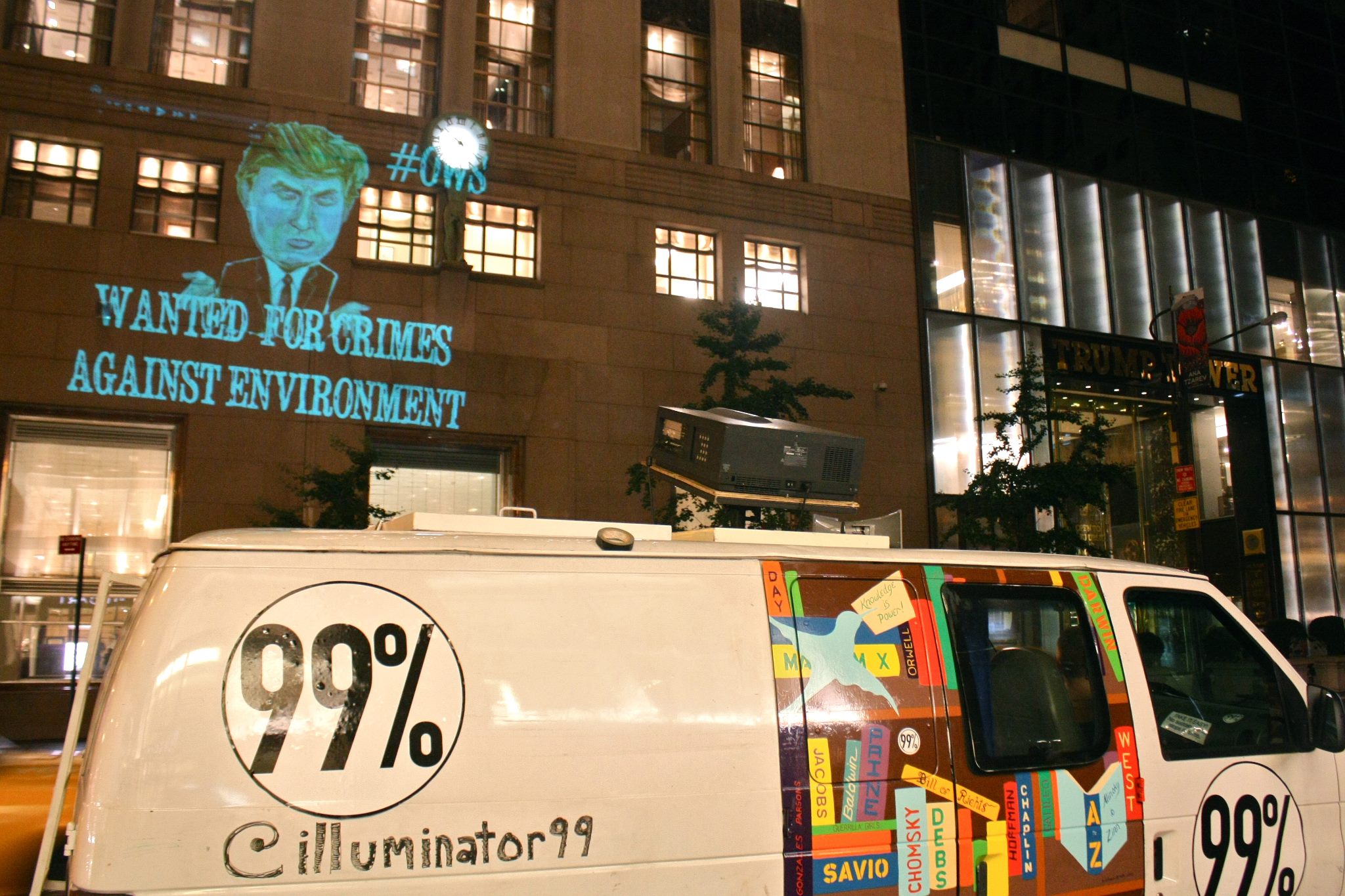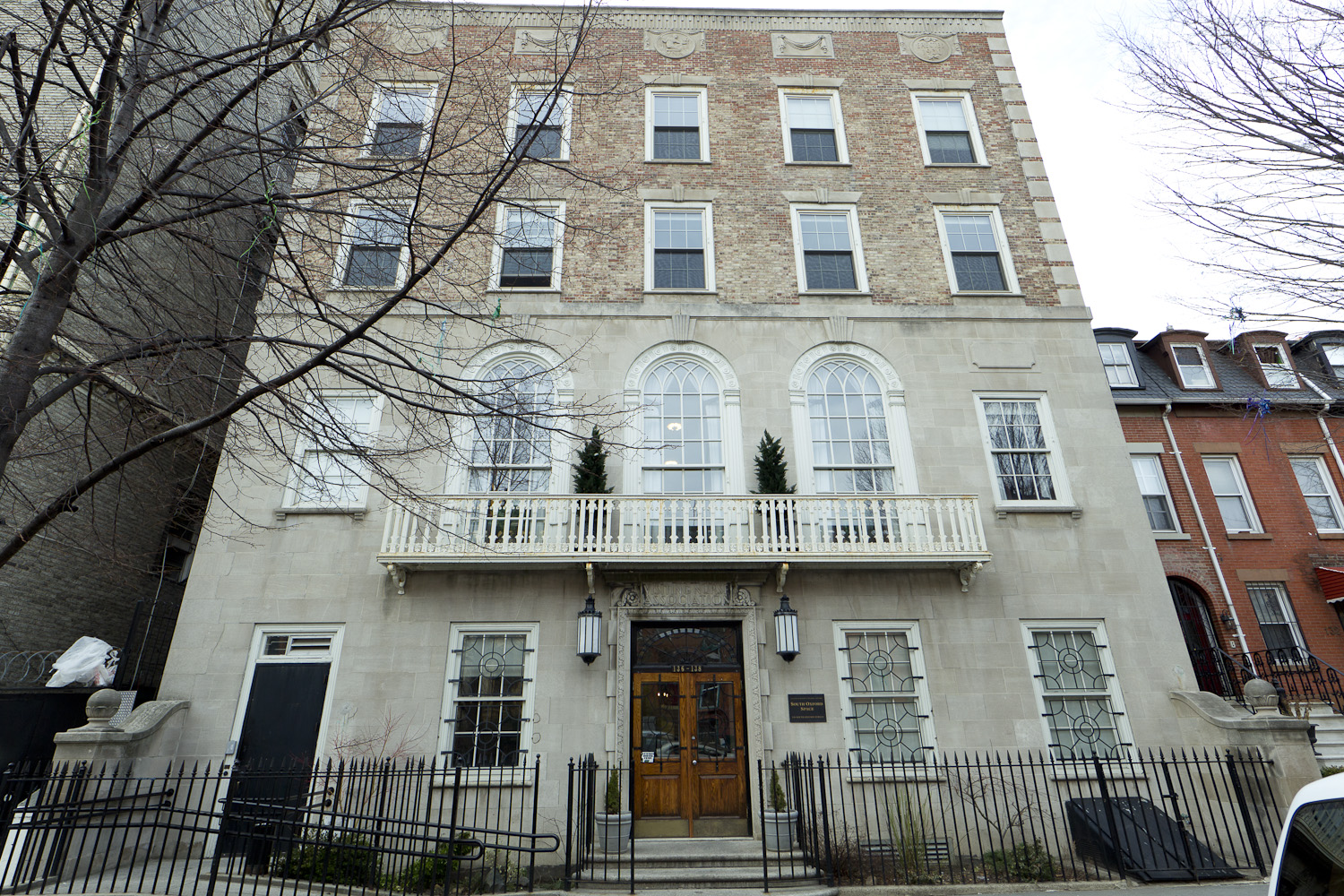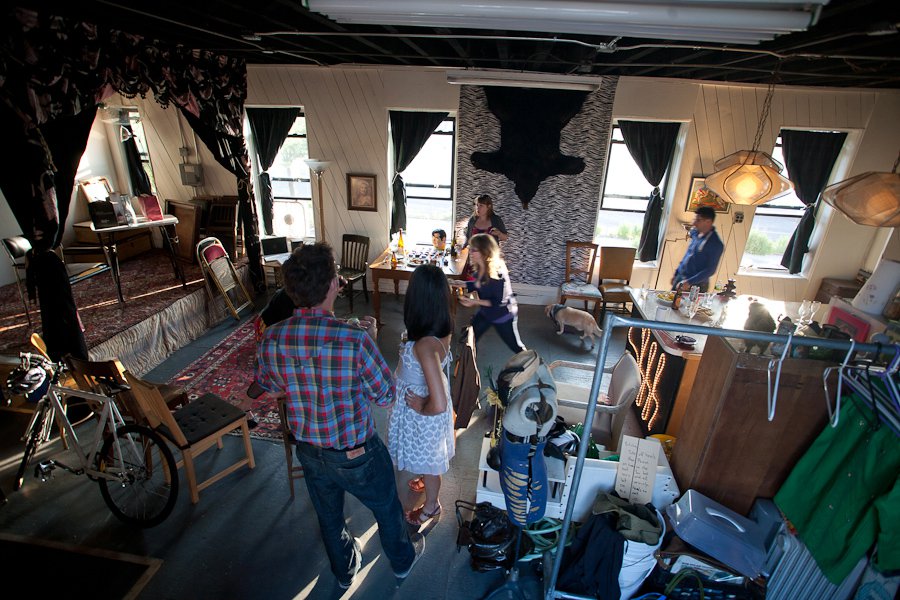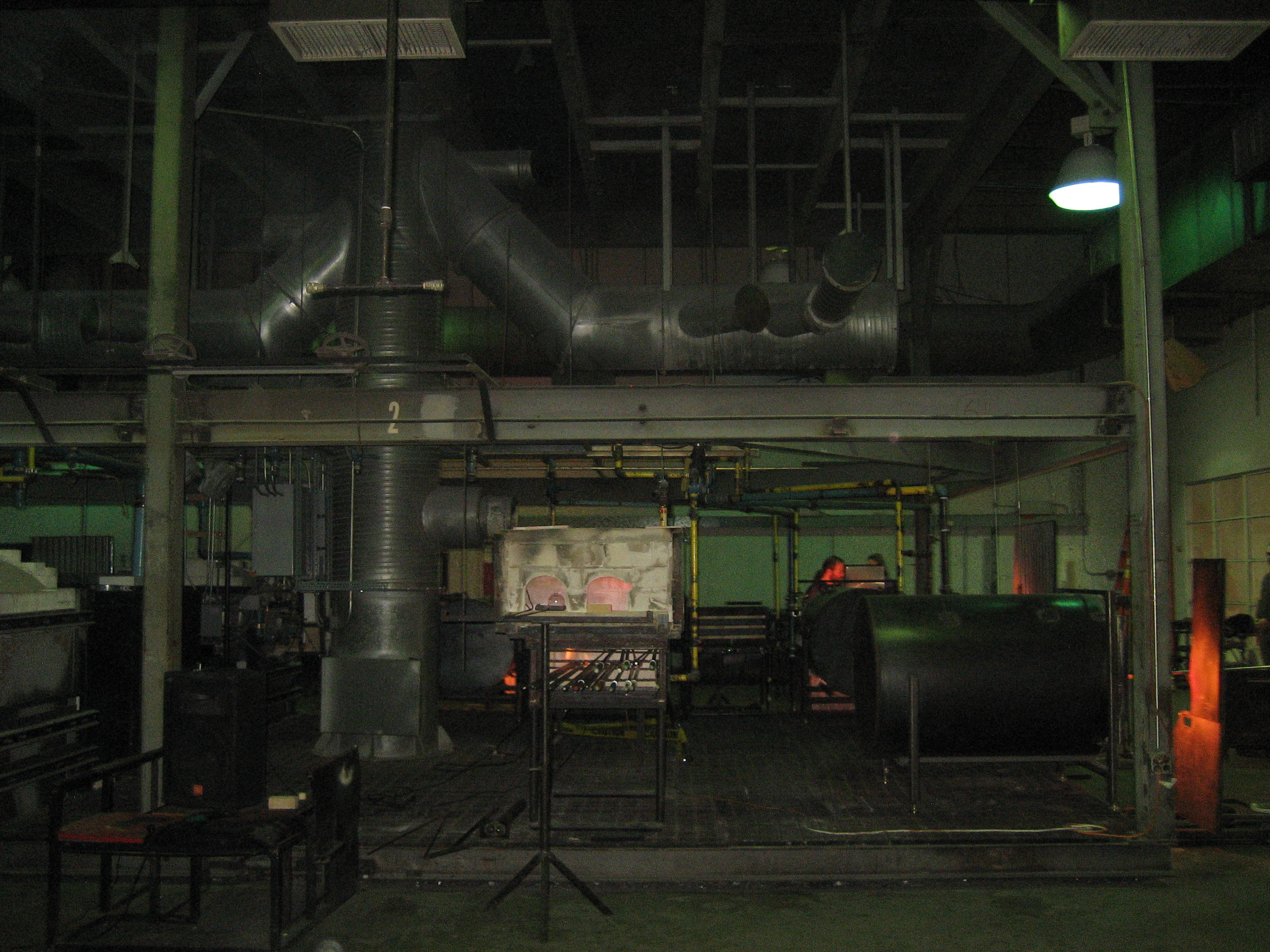the illuminator
space type: maker, activism | neighborhood: ft. greene & all over | active since: 2012 | links: website, facebook, twitter
For many involved in the Occupy Wall Street movement, the two-month anniversary last November was a galvanizing moment. As tens of thousands of activists marched over the Brooklyn Bridge, light projections suddenly appeared on the Verizon building nearby: things like “99%” “MIC CHECK” “#occupy,” and more. I was on that march and it was absolutely electrifying to see. We screamed and clapped and chanted, and the people driving by beneath us honked and cheered out their windows. It was an incredible moment.
In the wake of that action, Mark Read, the one who pulled it off, decided that had been just the beginning. He talked it over with Ben Cohen, a longtime friend of the movement, who eventually agreed to fund the construction of a customized vehicle for mobile guerilla projections. The guy tapped to construct the unit was Chris Hackett—one of the rulers of the Brooklyn maker scene, and cofounder of the art combine Madagascar Institute. Unsurprisingly, Hackett built a formidable machine, and the Illuminator was born.
Mark put out the call and amassed a merry band of activists to bottom-line the project. The Illuminator has been a smashing success, riding through protests from OWS actions to Occupy Town Square performances, partnering with community groups like rent-strikers in Sunset Park and workers’ rights activists in Midtown, projecting slogans and pictures onto the Russian Consulate, the British Embassy, Independence Hall in Philadelphia, the Williamsburg Bridge, and on and on.
The Illuminator is at a crucial stage in their journey right now, because they’re about to lose their funding. So this is the last week of their Kickstarter campaign, which, if successful, will allow them not only to keep this van, but to build more for use around the country. You should absolutely donate to their fund, but first read my interview with some of the activists involved.
brooklyn spaces: What was the first outing and the first projection?
Mark: The debut was March 3rd, for Low Lives, a virtual online performance-art project. We went all over that night: Zuccotti Park, the Whitney Museum where we projected the cheap art manifesto from the Bread and Puppet Theatre, down to Cooper Union, and then to Chase Bank.
brooklyn spaces: Do you plan the art before each action? Do you make it yourselves? Where does it come from?
Lucky: We produce a lot ourselves, but the great thing about this is it really is a Occupy resource, and more than that, it’s an activist resource. We reach out to lots of groups around the city, like the Sunset Park rent-strikers and the Hot & Crusty workers, and the messaging always comes from the people we’re supporting.
brooklyn spaces: How do you decide what projects the Illuminator will get involved with?
Annabelle: Well, it started with the 99%, and anything that could fit into that. We did that first projection two days after the eviction from the park.
Talia: I think it has to come from a positive space, people have to be happy about it. There has to be that exciting kind of antagonism.
Lucky: I think this goes back to the collective way we’re run. When we want to do something, there’s automatically a dialogue. We all come from very disparate backgrounds—I’m a biologist, Annabelle is a union researcher, and Mark does media, just to name a few—which really enriches the project, because we bring so many different perspectives.
Mark: Here’s a funny example of something we wouldn’t do. We were contacted by Woody Harrelson, and he wanted us to do some marketing for his upcoming Off-Broadway play, Bullet for Adolph. We’ve done work for hire before; we do have to keep the van in gas and parking. But what he wanted us to project was “Adolph is coming.” He was willing to pay us ten thousand dollars, which of course we could have really used, but we just couldn’t do it, it was too awful.
brooklyn spaces: Tell me about some of the site-specific projections.
 Lucky: When we do site-specific stuff, it’s more to do with the people who are rallying around the cause, or the cause itself. The van sort of becomes the hero, popping up and supporting causes, so when students go on an education strike, or renters go on rent strike, we’re part of those actions. There was the action with Occupy Tape, which was an action against Spectra, and we did a “Free Pussy Riot” projection on the Russian Consulate.
Lucky: When we do site-specific stuff, it’s more to do with the people who are rallying around the cause, or the cause itself. The van sort of becomes the hero, popping up and supporting causes, so when students go on an education strike, or renters go on rent strike, we’re part of those actions. There was the action with Occupy Tape, which was an action against Spectra, and we did a “Free Pussy Riot” projection on the Russian Consulate.
 Mark: I think the first site-specific one was at Atlantic Yards. There was a mic check, a call-and-response thing about what had happened with the Barclays Center, and a piece that was produced by our community partner in that case, Develop Don’t Destroy Brooklyn. The police were all over us that night and we sort of had to outwit them, which has been the case several times since. It was like a cat-and-mouse game.
Mark: I think the first site-specific one was at Atlantic Yards. There was a mic check, a call-and-response thing about what had happened with the Barclays Center, and a piece that was produced by our community partner in that case, Develop Don’t Destroy Brooklyn. The police were all over us that night and we sort of had to outwit them, which has been the case several times since. It was like a cat-and-mouse game.
brooklyn spaces: So the cops are not too fond of the Illuminator.
Dan: Like with the rest of Occupy, there’s a pattern of repression. The police want to disrupt people coming together, and the Illuminator rallies people and gets them excited, so we’re the last thing they want. Often they shut us down by making things up. I got a summons for disorderly conduct that we went to court for, and they didn’t even prosecute it because they knew it was bullshit. Another time they came out with a ticket already written and then asked “How is this projector mounted?” I said, “It’s bolted to this steel bar which is welded to the frame of the vehicle.” And they were like, “Um, this is a danger to pedestrians. It might fall off.”
Lucky: It’s about claiming contested space. In Zuccotti we were occupying a physical park, but the Illuminator is after the advertising space, the commercialized space above our heads and in our eye-line. So it’s predictable that that same sort of repression would happen, because we’re doing something powerful by subverting the order of things, the way society is constructed in a corporatized way.
brooklyn spaces: What’s been the most meaningful part of this project for you all?
Mark: For me, getting away with things is pleasurable, and getting people excited in an action context is awesome. There’s also the pleasure of talking to strangers, having conversations about the state of affairs in this country and the world, the kinds of crises we’re facing, what it’s going to take to solve those problems. Once these young kids came up to us, totally excited, and said, “Are you guys with the revolution?” I was like, “I hope so!”
Lucky: One of my favorite moments was Independence Hall in Philly, because that was totally spontaneous, and it often feels better when you don’t overwork yourself with planning and details. We were driving down to D.C. and saw Independence Hall to our left and figured, “Why not?” and went and projected “99%” onto the building. And as it happened, there were a bunch of Occupiers right there who took pictures and tweeted it all over. This is sort of a media machine, and a critique of mainstream media is that it privileges special interests in voice. Occupy has done a lot to use the power of modern technology to amplify important stories, and the Illuminator does that really well.
 Talia: For me the best is feeling like a part of this well-oiled activism machine, and in Philly it really gelled for me how powerful this is, doing that projection and then seeing our image bouncing all around the internet afterward.
Talia: For me the best is feeling like a part of this well-oiled activism machine, and in Philly it really gelled for me how powerful this is, doing that projection and then seeing our image bouncing all around the internet afterward.
Dan: It’s the most re-tweeted thing we’ve ever done, I think. But for me it’s also about the one-on-one stuff. One of my favorite Occupy chants is “Occupy will never die / Evict us, we multiply.” This is like a manifestation of that, because we can spread all over the city and even the country in a totally different way.
Talia: And since the Illuminator 1.0 is going to be shut down, the idea of multiplying, of 2.0, is awesome. One van is great, but it’s limiting. A broader, more mobile fleet all around the nation? That’s really exciting. There’s this brand new energy fueled by all our ideas for what we’ll do next.
***
Like this? Read about more activism: #OWS art show, No-Space, Time’s Up, Brooklyn Free Store, Books Through Bars, Bushwick City Farms, Trees Not Trash







































